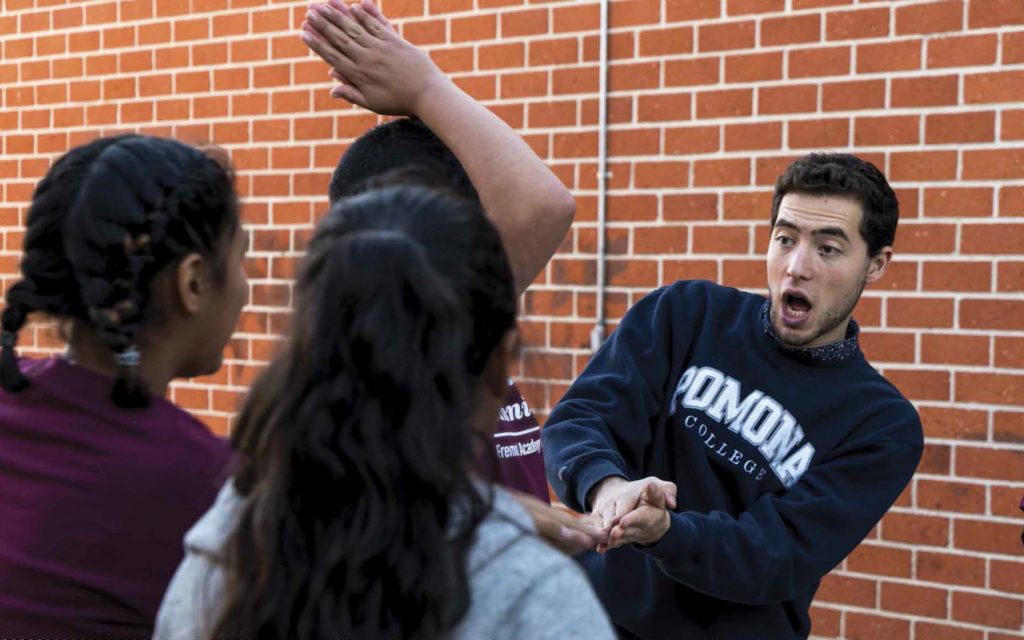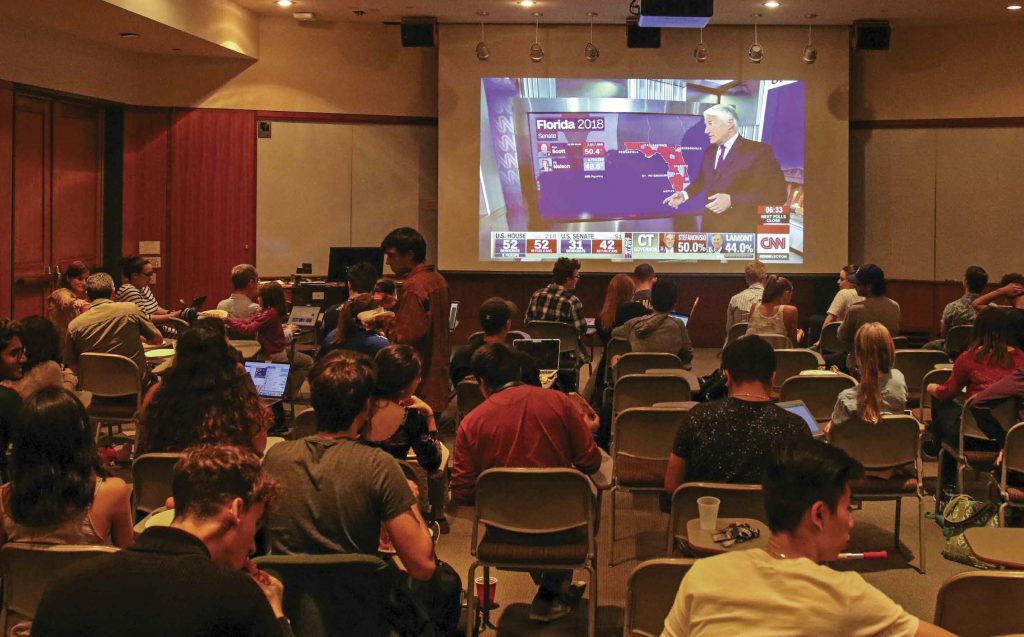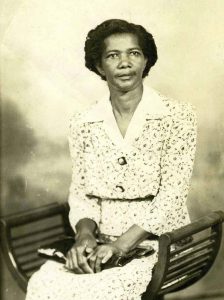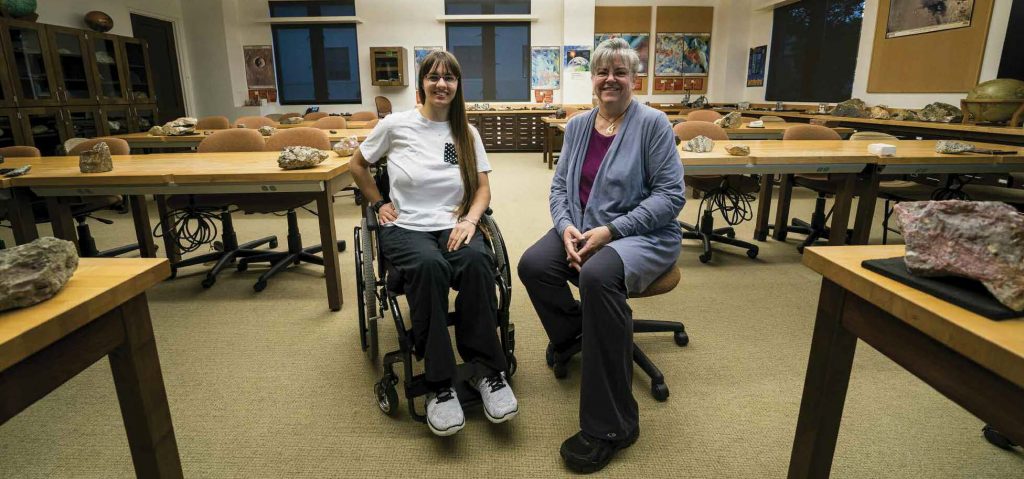 In a rite of passage, first-year students at Pomona begin their lives on campus with a Critical Inquiry seminar. These seminars focus on developing writing skills as students collaborate with peers, professors and student mentors to refine their drafts. The familiar five-paragraph format and the strict word counts of admissions essays are left behind. Here’s a look at a few of the new courses offered last fall:
In a rite of passage, first-year students at Pomona begin their lives on campus with a Critical Inquiry seminar. These seminars focus on developing writing skills as students collaborate with peers, professors and student mentors to refine their drafts. The familiar five-paragraph format and the strict word counts of admissions essays are left behind. Here’s a look at a few of the new courses offered last fall:
Lessons from the Mouse
Professor of Art Lisa Auerbach had never been to Disneyland until a birthday celebration a few years ago. She found herself surprised and curious. “Disneyland felt to me like a subject that everyone already has a relationship with, whether you’re a local person here who knows someone who works there, or you grew up going there, or you’re an international student who has grown up with Disney movies. I don’t think there is a place it hasn’t touched,” she says. “It provides for me the opportunity to make Disneyland into this lens to look at other kinds of things. We can use Disneyland to look at, for example, race and gender and pop culture. Or we can use Disneyland as an example when we talk about labor.” Labor issues were in the news this summer as Disneyland workers pressed for a “living wage.” Gender issues were at the forefront too, as the Pirates of the Caribbean ride reopened after an update that removed a banner at an auction scene that had read, “Take a wench for a bride.” Yet for all the complicated ways in which nostalgia, utopia, commerce and reality converge in Anaheim, “there is a magical ‘there’ there,” Auerbach says. And yes, there is a field trip.
The Politics of Protest
The Women’s March. The Arab Spring. The Tea Party protests. Tiananmen Square. And of course, the Civil Rights Movement. “There’s always something going on somewhere in the world,” says Professor of Politics Erica Dobbs, a new faculty member teaching her first ID1, based on a first-year seminar she taught at Swarthmore College. “Every year, there’s been an ideological mix,” Dobbs says, noting that many of her previous students had participated in protests. Some of the questions considered include what makes a protest a success or a failure, the role of historical memory and whether social media is a positive. “Social media and the internet have changed the game when it comes to mobilization, but at the end of the day the powers that be are still more concerned about people taking to the streets than taking to their keyboards,” Dobbs says.
Math + Art: A Secret Affair
Mathematics Professor Gizem Karaali wants to put to rest the idea that everyone is either a math person or an art person. A sculpture of the symbol for pi sits on her desk. On her whiteboard are two colorful designs that turn out to be geometric art by her husband and 9-year-old daughter. The textbook is a $49 coffee-table book, Mathematics and Art: A Cultural History, by Lynn Gamwell, including work by the artist M.C. Escher, with his stairways and tessellations. “We find his work fascinating because it’s visually interesting, but also mathematically, what’s happening?” Karaali says. The course also explores concepts such as proportion, infinity and symmetry in other less-expected artists, in some cases considering their mathematical context for the first time.
Governing Climate Change
Acknowledging climate change is one thing. Figuring out what to do about it is another. Professor of Politics Richard Worthington takes on the complex topic of how local, state, national and international governmental groups are addressing climate change, with a particular focus on climate justice. “Climate justice is really built off the idea of environmental justice, this aspiration that people have basically equal access to environmental benefits and amenities and equal protection against environmental hazards,” he says, noting that the countries that have done the most to create the problem, such as the U.S. and China, aren’t the ones most affected. Geography makes a big difference, Worthington points out. For example, he says, “small islands, with sea level rise, are going to be hit harder.”
Statistics in the Real World
In a playful twist on the old Trident commercial, the full title of Mathematics Professor Jo Hardin’s updated ID1 seminar includes the phrase, “9 out of 10 Seniors Recommend This First-Year Seminar.” The class focuses on both good and dubious uses of statistics in politics, the media and scientific studies, with particular attention to the 2016 presidential election. “Every year I have a couple of students who take it because they think the seniors recommended it,” Hardin says. “I think to myself, ‘You’re the person who should be in the class.’”

 It’s Friday, and this week’s farm-to-table special at the Sagehen Café is a vegetable and mushroom risotto with organic beets, carrots, joi choi, zucchini, yellow squash, garlic and onions, most of it grown and harvested nearby at the Pomona College Organic Farm. For the past five years, the on-campus restaurant, housed in Pomona’s Smith Campus Center, has offered a Friday special made with fresh, organic ingredients from the student-run farm. If you want to try it, though, you may need to arrive early, because according to the café’s general manager, Cheryl Yarck, it usually sells out.
It’s Friday, and this week’s farm-to-table special at the Sagehen Café is a vegetable and mushroom risotto with organic beets, carrots, joi choi, zucchini, yellow squash, garlic and onions, most of it grown and harvested nearby at the Pomona College Organic Farm. For the past five years, the on-campus restaurant, housed in Pomona’s Smith Campus Center, has offered a Friday special made with fresh, organic ingredients from the student-run farm. If you want to try it, though, you may need to arrive early, because according to the café’s general manager, Cheryl Yarck, it usually sells out.

 Driving back to campus from L.A. late one night, computer science major Eberto Andre Ruiz ’19 felt himself drifting off at the wheel. Worried, he grasped for a solution.
Driving back to campus from L.A. late one night, computer science major Eberto Andre Ruiz ’19 felt himself drifting off at the wheel. Worried, he grasped for a solution. In a rite of passage, first-year students at Pomona begin their lives on campus with a Critical Inquiry seminar. These seminars focus on developing writing skills as students collaborate with peers, professors and student mentors to refine their drafts. The familiar five-paragraph format and the strict word counts of admissions essays are left behind. Here’s a look at a few of the new courses offered last fall:
In a rite of passage, first-year students at Pomona begin their lives on campus with a Critical Inquiry seminar. These seminars focus on developing writing skills as students collaborate with peers, professors and student mentors to refine their drafts. The familiar five-paragraph format and the strict word counts of admissions essays are left behind. Here’s a look at a few of the new courses offered last fall: Alida Schefers ’21 usually makes the first contact with her professors to let them know she uses a wheelchair and may need accommodations. Last year, however, it was Professor of Geology Linda Reinen who contacted Schefers, inviting her to visit the classroom where Reinen’s Intro to Geohazards class would take place and talk over plans for the class field trip. Since then, the bond between Schefers and Reinen has strengthened, and the classroom experience has changed for the better—for all of Reinen’s students.
Alida Schefers ’21 usually makes the first contact with her professors to let them know she uses a wheelchair and may need accommodations. Last year, however, it was Professor of Geology Linda Reinen who contacted Schefers, inviting her to visit the classroom where Reinen’s Intro to Geohazards class would take place and talk over plans for the class field trip. Since then, the bond between Schefers and Reinen has strengthened, and the classroom experience has changed for the better—for all of Reinen’s students.